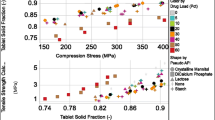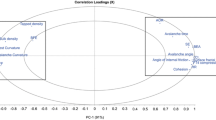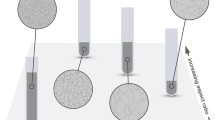Abstract
The flow properties of typial tablet and capsule formulation excipients, active compounds, and representative formulation blends were tested with current and novel flow measurement techniques to identify a reliable bench test to quantify powder flow as a screening method in early tablet and capsule formulation development. Test methods employed were vibrating spatula, critical orifice, angle of repose, compressibility index, and avalanching analysis. Powder flow results from each method were compiled in a database, sorted, and compared. An empirical composite index was established and powder flow was ranked in accordance with formulator experience. Principal components analyses of the angle of repose, percent compressibility, and critical orifice of the powder materials were also performed. The first principal component accounted for 72.8% of data variability; scores associated with this principal component score can serve as an index of flowability. Data generated from vibrating spatula and avalanching methods were not reproducible and were inconsistent with formulator experience and cited vendor references for flow. Improvements of test instruments and further studies are necessary for better assessment of these approaches.
Similar content being viewed by others
References
Carr R. Evaluating flow properties of solids.Chem Engineering. January 18, 1965;163–168.
Jenike AW. Flow of solids in bulk handling systems.Bull Univ Utah. 1954;64.
Augsburger L, Shangraw RFJ Pharm Sci. 1966;55:418.
Gioia A. Intrinsic flowability: a new technology for powder-flowability classification.Pharm Tech. February 1980:65–68.
Hickey AJ, Concessio N. Flow properties of selected pharmaceutical powders from a vibrating spatula.Part Part Syst Charact. 1994;11:457–462.
Kaye BH. Applied fractal geometry and the fineparticle specialist. (pt1). Rugged boundaries and rough surfaces.Part Part Syst Charact. 1993;10:99–110.
Kaye BH. Fractal dimensions in data space: new descriptors for fineparticle systems.Part Part Syst Charact. 1993;10:191–200.
Garcia TP, Taylor MK, Pande GS. Comparison of the performance of two sample thieves for the determination of the content uniformity of a powder blend.Pharm Dev and Tech. 1998;3:1–6.
Wade A, Weller PJ.Handbook of Pharmaceutical Excipients. American Pharmaceutical Association, Washington, DC: The Pharmaceutical Press; 1994:85.
Crowder T, Sethuraman V, Fields T, Hickey AJ. Signal processing and analysis applied to powder behaviour in a rotating drum.Part Part Syst Charact. vol 16, Issue 4, 10/25/99, pp 191–196.
Amidon GE, Bergren MS, Grant DJW, Marshall K, Itai S. Physical test methods for powder flow characterization of pharmaceutical materials: a review of methods, stimuli to the revision process.Pharmacopeial Forum. 1999;25:8298–8308.
Staniforth JN. Powder Flow. In: Rubinstein MH, ed.Pharmaceutical Technology: Tabletting. Prentice Hall, Upper Saddle River, New Jersey: Halsted Press; 1987:600–615.
Author information
Authors and Affiliations
Corresponding author
Rights and permissions
About this article
Cite this article
Taylor, M.K., Ginsburg, J., Hickey, A.J. et al. Composite method to quantify powder flow as a screening method in early tablet or capsule formulation development. AAPS PharmSciTech 1, 18 (2000). https://doi.org/10.1208/pt010318
Received:
Accepted:
DOI: https://doi.org/10.1208/pt010318




